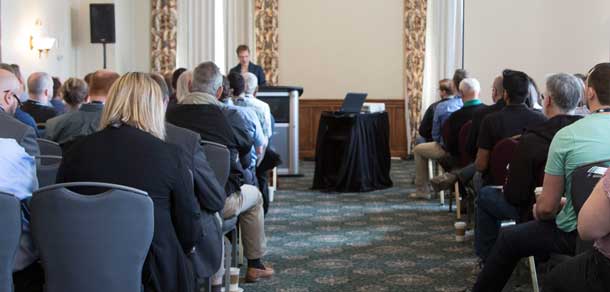Life, especially in the world of engineering, can be a bit like a game of Whack-A-Mole. You smash down one problem and four more crop up.
For her presentation at the Annual Meeting, Margot Hurlbert, PhD, LLB, LLM, BAdmin calls a “wicked problem” – one in which there are no easy, black-and-white answers and in which the solution may well cause as many or more problems as the original issue.
As an example, she points to the single biggest public health crisis in New York City in the 19th century – horse manure left behind by the city’s main mode of transportation. This problem was totally solved by the invention of the automobile – which then contributed to greenhouse gas emissions and climate change.
Hurlbert’s research focus is on governance and climate change, energy and water. She has participated in and led research projects focusing on aspects of governance including energy, water, agricultural producer livelihoods, drought and flood.
As Hurlbert describes, “climate change represents the most severe wicked problem humanity has faced to date.”
“Some say we should just leave the oil in the ground. But petroleum is used for many other things besides fuel. Most of the clothes I’m wearing have some petroleum component. If we eliminated oil, how much land would have to be taken out of food production to support growing more cotton to replace artificial fabrics?”
Solving the problem will cause severe economic and social repercussions but ignoring it could lead to worse consequences.
Hurlbert notes that the Intergovernmental Panel on Climate Change (IPCC) and the Paris Accord on climate change require that the world achieve a zero-carbon emissions level by 2050 in order to avoid the worst consequences of climate change.
Getting to that zero-carbon state will be profoundly difficult, to say the least. Simply achieving political consensus on this objective is proving elusive given the continued influence of climate change deniers and others who minimize the problem.
However, the influence of climate change deniers is not the only or even the most difficult hurdle in achieving public consensus. For example, the IPCC plan requires increased use of carbon capture, yet government and industries have been slow to adopt these technologies, in part because of their expense. Similarly, the IPCC objectives could be achieved through proven, existing small modular nuclear reactors, yet there is sharp public resistance to this technology, often by the same people who are the most vocal supporters of climate change action.
Even on the topic of oil, a frequent target of climate change activism, Hurlbert notes that there are no simple solutions.
Eliminating petroleum as a fuel source would likewise cause complications.
“The IPCC plan also requires complete conversion to electric cars. But here in Saskatchewan there is no way the provincial grid could keep up with the increased electrical demand through conventional or renewable sources. We could achieve it with small nuclear generation, but then we would face public backlash,” Hurlbert says.
Efforts at electrical conservation have also faced challenges, such as smart meter initiatives that have run into technical problems in many jurisdictions, including Saskatchewan, where they have been implemented.
On the bright side, Hurlbert notes that a number of so-called “terraforming” technologies have been developed, such as a facility in Switzerland that sucks carbon directly out of the atmosphere and converts it into useful products. However, these technologies may lead to their own unintended consequences and raise the question of whether mankind has the capacity to reverse engineer the planet’s climate.
“None of these questions have easy answers but engineers and geoscientists will nonetheless be heavily involved in trying to find the answers. These issues of technology, resource use, the environment and risk management are all areas on which policymakers routinely look to your professions for guidance. I encourage engineers and geoscientists to be active in becoming aware of these issues, thinking about solutions and providing the best counsel you can to policymakers and the public at large,” said Hurlbert at the APEGS Annual Meeting.
